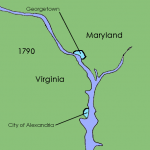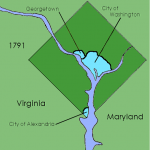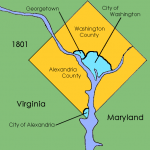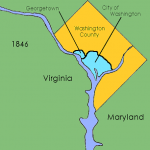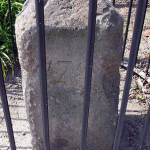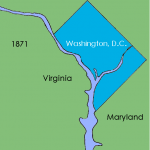The Founding of Washington, D. C.
The United States capital was originally located in Philadelphia, beginning with the First and Second Continental Congress, followed by the Congress of the Confederation upon gaining independence. In June 1783, a mob of angry soldiers converged upon Independence Hall to demand payment for their service during the American Revolutionary War. Congress requested that John Dickinson, the governor of Pennsylvania, call up the militia to defend Congress from attacks by the protesters. In what became known as the Pennsylvania Mutiny of 1783, Dickinson sympathized with the protesters and refused to remove them from Philadelphia. As a result, Congress was forced to flee to Princeton, New Jersey on June 21, 1783.
Dickinson’s failure to protect the institutions of the national government was discussed at the Philadelphia Convention in 1787. The delegates therefore agreed in Article One, Section 8, of the United States Constitution to give the Congress the power:
To exercise exclusive legislation in all cases whatsoever, over such District (not exceeding ten miles square [259 km²]) as may, by cession of particular states, and the acceptance of Congress, become the seat of the government of the United States, and to exercise like authority over all places purchased by the consent of the legislature of the state in which the same shall be, for the erection of forts, magazines, arsenals, dockyards, and other needful buildings.
James Madison, writing in Federalist No. 43, also argued that the national capital needed to be distinct from the states, in order to provide for its own maintenance and safety. The Constitution, however, does not select a specific site for the location of the new District. Proposals from the legislatures of Maryland, New Jersey, New York, and Virginia all offered territory for the location of the national capital. Northern states preferred a capital located in one of the nation’s prominent cities, unsurprisingly, almost all of which were in the north. Conversely, Southern states preferred that the capital be located closer to their agricultural and slave-holding interests. The selection of the area around the Potomac River, which was the boundary between Maryland and Virginia, both slave states, was agreed upon between James Madison, Thomas Jefferson, and Alexander Hamilton.
On December 23, 1788, the Maryland General Assembly passed an act, allowing it to cede land for the federal district. The Virginia General Assembly followed suit on December 3, 1789. The signing of the federal Residence Act on July 6, 1790, mandated that the site for the permanent seat of government, “not exceeding ten miles square” (100 square miles), be located on the “river Potomack, at some place between the mouths of the Eastern-Branch and Connogochegue”. The “Eastern-Branch” is known today as the Anacostia River. The Connogocheque (Conococheague Creek) empties into the Potomac River upstream near Williamsport and Hagerstown, Maryland.) The Residence Act limited to the Maryland side of the Potomac River the location of land that commissioners appointed by the President could acquire for federal use.
The Residence Act authorized the President to select the actual location of the site. However, President George Washington wished to include the town of Alexandria, Virginia within the federal district. To accomplish this, the boundaries of the federal district would need to encompass an area on the Potomac that was downstream of the mouth of the Eastern Branch. The U.S. Congress amended the Residence Act in 1791 to permit Alexandria’s inclusion in the federal district. However, some members of Congress had recognized that Washington and his family owned property in and near
Alexandria, which was just seven miles (11 km) upstream from Mount Vernon, Washington’s home and plantation. The amendment therefore contained a provision that prohibited the “erection of the public buildings otherwise than on the Maryland side of the river Potomac”.
The final site was just below the fall line on the Potomac, the furthest inland point navigable by boats. It included the ports of Georgetown and Alexandria. Â The process of establishing the federal district, however, faced other challenges in the form of strong objections from landowners such as David Burns who owned a large, 650-acre tract of land in the heart of the district. On March 30, 1791, Burns and eighteen other key landowners relented and signed an agreement with Washington, where they would be compensated for any land taken for public use, half of remaining land would be distributed among the proprietors, and the other half to the public.
Pursuant to the Residence Act, President Washington appointed three commissioners (Thomas Johnson, Daniel Carroll, and David Stuart) in 1791 to supervise the planning, design and acquisition of property in the federal district and capital city. In September 1791, the three commissioners agreed to name the federal district as “The Territory of Columbia,” and the federal city as the “City of Washington.”
Working under the general supervision of the three commissioners and at the direction of President Washington, Major Andrew Ellicott, assisted by his brothers Benjamin and Joseph Ellicott, Isaac Briggs, George Fenwick, and an African American, Benjamin Banneker, surveyed the borders of the Territory of Columbia with Virginia and Maryland during 1791 and 1792. The survey began at Jones Point, a cape located at the confluence of Hunting Creek and the Potomac River south of Alexandria.
The survey team enclosed within a square an area containing the full 100 square miles (260 km2) that the Residence Act had authorized. Each side of the square was 10 miles (16 km) long. The axes between the corners of the square ran north south and east west. The center of the square is within the grounds of the Organization of American States headquarters west of the Ellipse.
The survey team placed sandstone boundary markers at or near every mile point along the sides of the square. Many of these markers still remain. The south cornerstone is at Jones Point. The west cornerstone is at the west corner of Arlington County, Virginia. The north cornerstone is south of East-West Highway near Silver Spring, Maryland, west of 16th Street. The east cornerstone is east of the intersection of Southern Avenue and Eastern Avenue.
Almost immediately after the “Federal City” was laid out north of the Potomac, some residents south of the Potomac in Alexandria County, D.C. began petitioning to be returned to Virginia’s jurisdiction. Over time, a larger movement grew to separate Alexandria from the District for several reasons.
After a referendum, Alexandria County’s citizens petitioned Congress and Virginia to return the area to Virginia. By an act of Congress on July 9, 1846,and with the approval of the Virginia General Assembly, the area south of the Potomac (39 square miles; 101 km²) was returned, or “retroceded,” to Virginia effective in 1847.
The retroceded land was then known as Alexandria County, Virginia, and now includes a portion of the independent city of Alexandria and all of Arlington County, the successor t Alexoandria County. A large portion of the retroceded land near the river was an estate of George Washington Parke Custis, who had supported the retrocession and helped develop the charter in the Virginia General Assembly for the County of Alexandria, Virginia. The estate (Arlington Plantation) would be passed on to his daughter (the wife of Robert E. Lee), and would eventually become Arlington National Cemetery.
